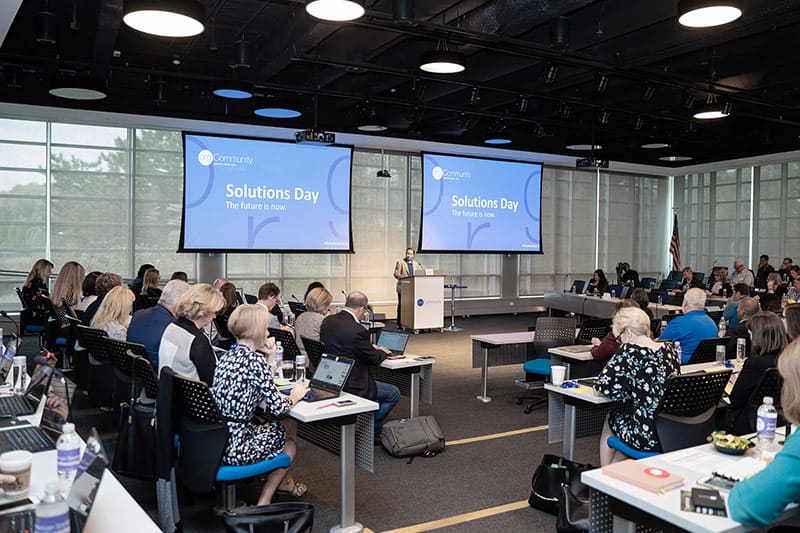What would you expect a conference called Solutions Day to deliver? Answers to tough questions, strategies to tackle challenges and new perspectives. Our speakers made good on that promise. In the next few posts, I’m highlighting some of my personal aha moments from the November 15 event.
If you’ve been considering how to make the most of new data that’s available from your association management system, Thad Lurie, number cruncher extraordinaire and vice president business intelligence at Experient, had some great recommendations. Thad’s presentation was a fascinating discussion on the practical and psychological impact of big data.
Data is the Foundation
Big data is a term that gets lots of airtime lately. It pops up in so many different contexts that the meaning can get lost in the chatter. Gartner, a leading IT and research advisory company, offers this definition: Big Data is high-volume, high-velocity and/or high-variety information assets that demand cost-effective, innovative forms of information processing that enable enhanced insight, decision making, and process automation.
In other words, we’re talking about mega sets of information from current and entirely new sources. (Think smart devices, social media, etc.) Advances in technology have dramatically reduced the cost and efficiency of storing and analyzing humongous chunks of disparate facts and figures. Data related to everything from customer preferences to fraud and compliance issues can be mined to reveal trends that would previously have been difficult to spot. Companies use this information to make smarter decisions about product development, provide improved customer service and proactively address a myriad of other issues. A data centered approach certainly supports the trend in the association community toward knowledge-based strategy and governance. But are facts enough to sway a critical argument?
Context Builds a Framework
One of the take-aways that made Lurie’s talk unique for me was his emphasis on the need to balance numbers, context and psychology. Yes, business decisions should be based on data, and the more information you have the better. All the new facts you can mine from your AMS are seductive. But naked numbers are of little value. If statistics are the foundation, context is the framework for your argument. It provides the rationale and the wide-angle view of the issues—answering questions such as:
- How was the data collected?
- How do the numbers relate to each other?
- When you look at the big picture do the results make sense?
- How do the findings stack up against the needs?
Lurie used the real estate site Redfin to explain the benefit of context. The price of a single home is not a good indicator of its actual value. Redfin provides both relational and emotional context. Users can compare the cost and features to other homes in the area. They can also assess whether neighborhood services such as schools, transportation and businesses meet their family’s needs. In addition, taxes and other related data is also available. This information gives the home’s price meaning in the marketplace and against a buyers’ personal requirements.
Psychology Sells the Idea
If you’ve run accurate numbers and backed them with reliable context, is that enough to sell your board on the move to a larger office or any other significant initiative? Probably not, if you haven’t prepared for the HIPPO (highest paid person’s opinion). What association leader hasn’t heard a variation of this script:
Executive director: It’s time to sunset the black tie award dinner at the annual meeting, and here are the reasons why…
Board chair (HIPPO) interrupts: Why would we do that? I chaired the committee that developed that program. It’s incredibly popular. How else are we going to recognize our VIP members?
Executive director: It was well attended until about three years ago. Our membership demographic is changing, and registration is declining. The event is losing money and taking effort away from other important activities. Younger members prefer going out to dinner with their friends. My report summarizes the numbers and includes statistics on member preferences.
Board chair: I read the report. But you’re not considering who attends. Most of the people on this board have been honored at that dinner. It was an important event in their careers. Let’s take a vote right now.
Is data going to win this argument? Not without psychology and some gamesmanship. When you face off with the HIPPO, take Lurie’s advice, and remember the Backfire Effect. This term was coined by political scientists Brendan Nyhan and Jason Reifler to describe the negative reaction that occurs when people’s deep-seated beliefs run up against contradictory facts. (A good reason why political arguments at the holiday dinner table turn toxic quickly.) It’s a pretty universal reaction. Resistance grows stronger in direct proportion to a person’s emotional investment in the opposing point of view.
With finesse and planning, you can minimize the backfire effect. These are Lurie’s tips for taming the HIPPO in the room:
- Do your homework and prepare stakeholders for the discussion in advance.
- Work together to define metrics for success
- Consider “what if” scenarios
- Present the information in a way that allows people to arrive at the outcome you are seeking by themselves
- Discuss don’t debate
- Listen empathetically and articulate what you hear
- Show respect for alternate opinions
- Emphasize that changing facts and activities does not necessarily mean changing world views
As a result of recent technology the power of data is growing exponentially. But without context the results are more noise than truth. Striking the right balance between data, context and psychology, puts muscle in the numbers. It will give your charts, graphs and statistics the power to be convincing.


